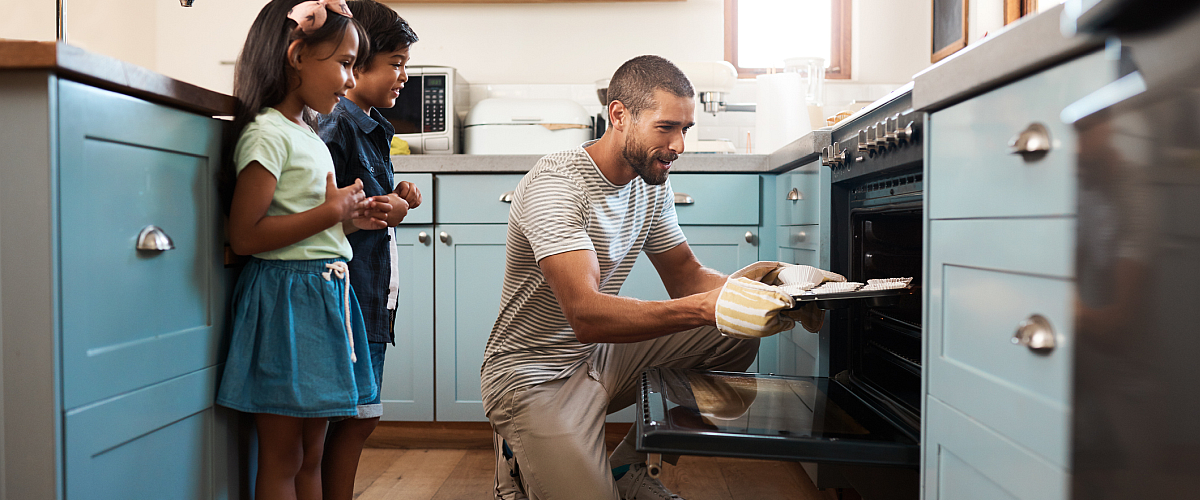From pots and pans to appliances and all the groceries and spices in between, is your space starting to feel a little … cramped?
Kitchens come in all shapes and sizes, and a cluttered one can often feel even smaller than it really is. We asked Lauren Cohen, an Aramark registered dietitian nutritionist (and self-proclaimed organizational expert!), as well as Chef Bill Allen to share some of the best, most efficient tips to update your kitchen design. Overall, there’s no reason to sacrifice style or functionality to maximize the use of your space.
1. GET VERTICAL
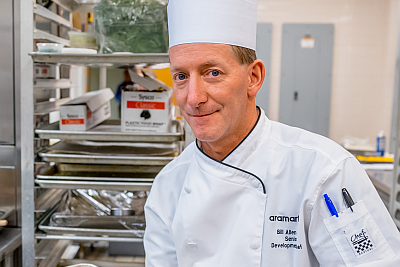
Here’s a universal truth of organizing: You can gain more space by looking up. “People tend to sprawl their possessions on horizontal surfaces, instead of working upward,” says Chef Bill.
In the kitchen, this concept can lead to several inexpensive solutions. Shop around your house, as there’s a good chance you already own the right tools. If not, most can be easily and inexpensively found at local stores or can be ordered for home delivery on-line.
- Hang tight: Tiered hanging baskets are great for fruits and veggies that don’t need refrigeration (like apples, bananas, avocados, and onions).
- Please rise: Metal risers can turn each shelf into two, stacking dishes much higher. “They work in your pantry to keep cans and boxes from toppling over, too,” Lauren mentions.
- Turn things around: Fit twice as much by storing rectangular items such as cutting boards, baking sheets, and platters on their short ends instead of longways—like books on a bookshelf.
But how high should you go? “Keep everyday food and tools within easy reach,” Chef Bill advises. “Then special-occasion items can go up high, even on top of your cabinets. This draws your eye upward and makes the room feel taller (as long as it’s tidy!)”
2. UNCOVER HIDDEN SPACES

Empty wall and interior space is wasted space in a kitchen, Lauren tells us. Clearing off your counters will make your kitchen appear larger, and displaying select items will make it feel homier.
- Wall of wonders: Hang pans, ladles, towels and potholders on adhesive wall hooks. Consider mounting these on the outer sides of your cabinets, the space above your oven range and your backsplash area.
- Peek inside: “The insides of cabinets doors are an often-forgotten space,” shares Lauren. “They’re perfect for paper towel rolls, dish gloves on a hook, or extra plastic grocery bags.” You can even repurpose an over-the-door shoe organizer in your pantry—the pockets will hold just about anything.
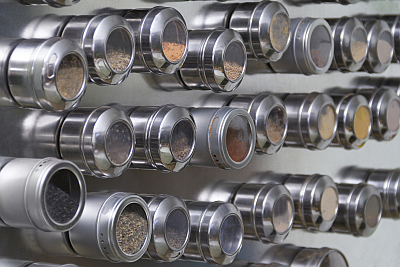
- Stick to it: Consider placing strong double-sided magnets (strip or singles) on the fridge to store a row of spices, rings of measuring spoons, and more near your prep space. While these are all great options, chose what’s best and safe for you and your family.
- Hidden in plain sight: Have a few inches of space between your fridge and the wall? Turns out this is a best-kept secret of kitchen organization. “Sure, you could store your mop and broom there—but this space can work even harder for you,” Lauren points out. “They make slim rolling shelves just for this purpose, to hold condiments, canned goods, and other pantry supplies.”
- Behold baskets and bins: Rely on small baskets to corral the tools and ingredients you use every day. This makes it easier to grab and return them to their proper place. You may prefer clear bins because, as Lauren puts it, “You can view what’s inside and avoid buying more than you need—which tends to lead to clutter.”
- Roll with it: This may sound counter-intuitive, but a rolling island or kitchen cart can make a huge difference in a small kitchen. “If space is at a premium, you can store bulk items like oats and flours underneath, while the top provides valuable prep space. Hide it in a corner or closet, then roll out when needed,” Chef Bill says.
What goes where? Display attractive kitchen items—serving bowls and platters, potted herbs, cookbooks, and so on—and save not-so-pretty items for your drawers and cabinets.
3. TAKE CONTROL OF STORAGE CONTAINERS
We love reusable containers for leftovers and keeping a week’s worth of chopped fruits and veggies handy for snacking.But organizing them is an exasperating job for seemingly every household. That’s why this task deserves some expert attention.
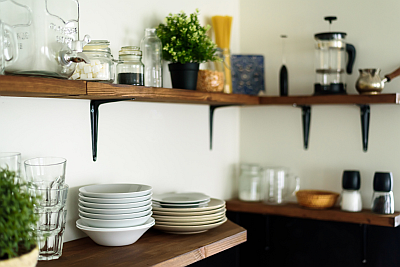
Chef Bill shows us how to sort them the smart way. (P.S. These steps work for any group of like items, such as cups, bowls, and platters.)
- Sort the containers by material (glass or plastic).
- Sort by shape (round, square, cylindrical, rectangular) and then nest by size.
- File all lids separately in a single container, making sure there is a lid for every container.
- Use drawer dividers to keep stacks tidy.
- Revisit your stash every six months or so (before it can take over your kitchen again).
Does your drawer still runneth over? “Re-evaluate how many containers you really need,” he recommends. “And if you can, purchase a full matching set so the pieces will be designed to fit together. The investment here doesn’t need to be large – $10 to $15 can help refresh most of your mismatched set!”
SMALL KITCHEN, BIG GOALS
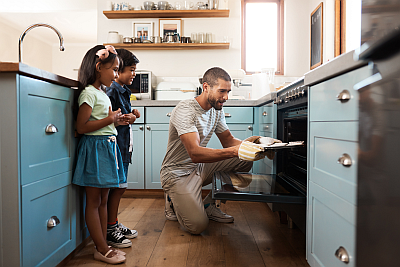
Your kitchen might be small, but these tips will make it mighty! In the name of spring (or any time of year!) cleaning, determine what you need, what you don’t, and where it all should go. And challenge yourself to take a fresh look—just because you’ve always kept the blender in a certain spot doesn’t mean it has to stay there.
“Whether you’ve lived in your home for a month or 10 years, it can be fun to take everything apart and put it back together in new ways,” encourages Chef Bill.
Discover more at-home projects from our experts, like planting a vegetable garden, brushing up on your knife skills, and getting the kids in the kitchen.
Note: Since everyone’s health history and nutritional needs are so different, please make sure that you talk with your doctor and a registered dietitian to get advice about the diet and exercise plan that‘s right for you.

